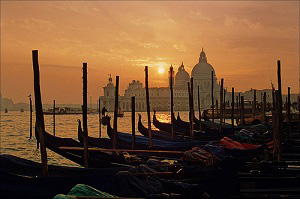
Venice Guide
Boat trips, gondola rides, walking tours, visiting the monuments, museums and churches, enjoying nightlife, you will never get bored of Venice. You will be overwhelmed by the Byzantine palaces, the beautiful arched bridges and charming squares. Through whole the city you will encounter the most beautiful places. You will be surprised by the tranquility in the narrow streets in contrast with the crowded touristic sites as the Piazza San Marco and the Rialto Bridge.
Venice is built on 117 different islands, divided by more than 160 canals and connected with each other by 400 bridges. Cars are therefore not permitted in the city centre, it´s simply impossible to go around by car. The historic centre, or centro storico in Italian, exists of six districts; San Marco, Cannaregio, Castello, Dorsoduro, San Polo and Santa Croce. The main tourist hotspot is San Marco, with the famous Piazza San Marco, the Basilica di San Marco, the Palazzo Ducale and the Ponte dei Sospiri. Also visit the San Polo district. Here you will find the Scuola Grande di San Rocco en the Campo San Polo. Don´t forget the nice and busy Rialto markets! Castello is one of the oldest parts of the city with lots of tourist attractions as the Viale Garibaldi, the Chiesa San Pietro di Castello and the Museo Storico Navale. As you can see; Venice is full of surprises!
History Venice
Already in Roman Times the name Venice was used to refer to the place where we can nowadays find the city of Venice. But it was not until 453 that Venice started to be a real settlement, as a result of the influx of refugees after the invasions of Attila and later the Lombards.
In the 7th century Venice became a part of the Byzantine Empire. In this period Venice was reigned by a local Byzantine governor, who they called the ´doge`. He settled in Malamocco in the south of the Lido island of Venice. It was not until the 9th century Venice became a city. More and more bridges were built to connect the different islands and in 828 St. Mark the Evangelist, the traditional author of the Gospel of Mark, became the patron saint of the city. Two Venetian merchants brought relics, which were believed to be the remains of St. Mark the Evangelist, to Venice. In order to house the relics the Basilica di San Marco was built.
The Venetian fleet controlled the Adriatic Sea and in exchange of supporting the Byzantine interests they received more independency and trade privileges. Venice became more and more a threat to cities as Genua and Pisa, but it also started to become more powerful than the Byzantine Empire. During the Fourth Crusade Venice plundered Constantinople and conquered a big part of the Byzantine Empire. The result was a hundred years war with Genua about who would dominate the eastern Mediterranean. This battle was won by Venice at the 13th of august 1380.
During the 12th, 13th and 14th century the Republic of Venice was flourishing and extremely wealthy.
With the takeover of Constantinople by the Turkish in 1453 Venice started to decline. Venice lost a lot of islands en sank into financial difficulties. Venice remained independent till Napoleon conquered the city on the 12th of May 1797. In 1861 the Kingdom of Italy was proclaimed of which Venice became a part in 1866.
